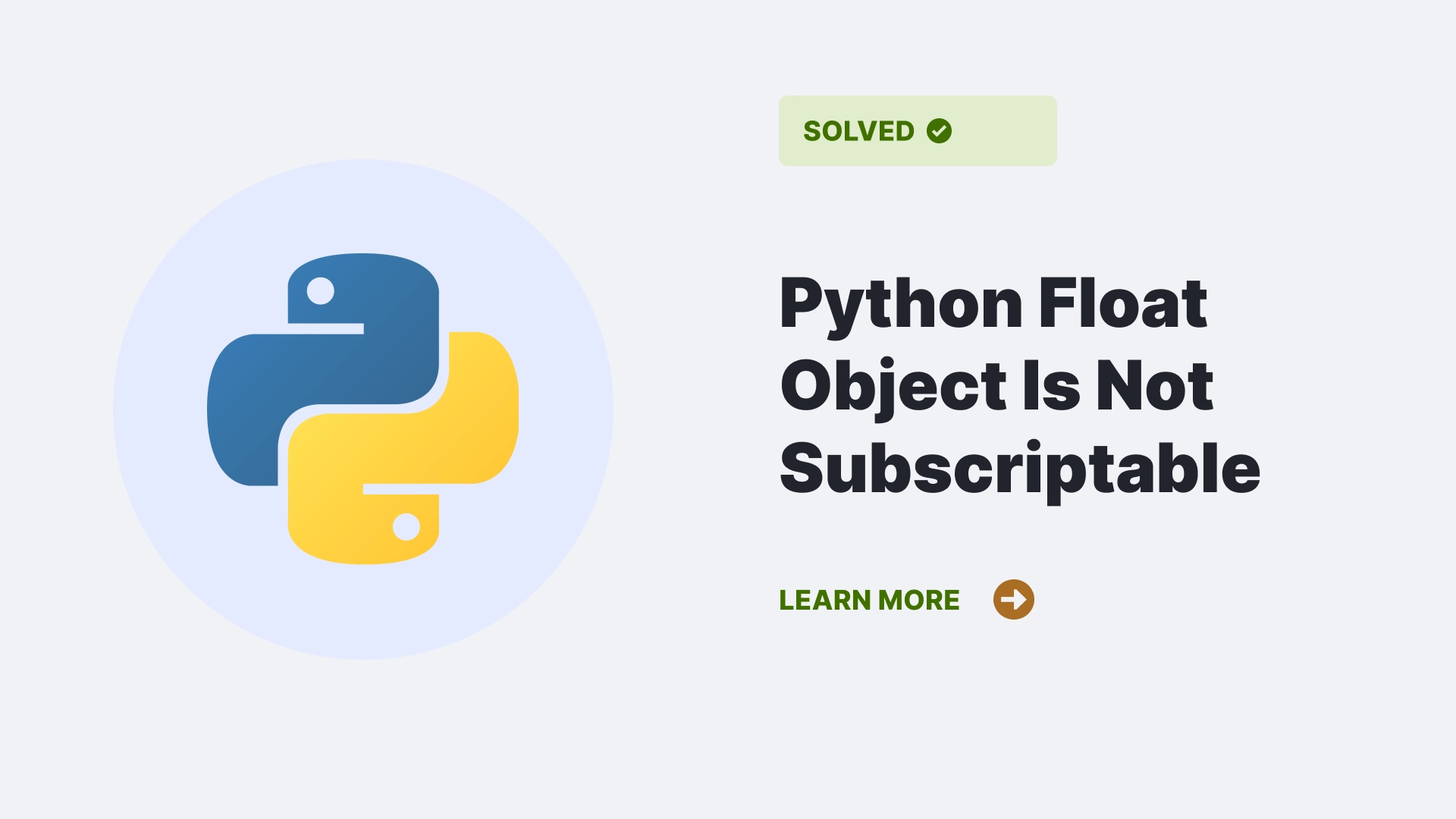The error message Python float object is not subscriptable occurs when we attempt to access or index a float object as if it were a list or a string. In Python, float objects are not subscriptable by design. This is because floats represent numeric values and are intended for mathematical calculations rather than for accessing individual elements or characters.
Contents
‘Python float object is not subscriptable’ error demonstration
The float objects are not subscriptable, meaning you cannot access individual elements or characters within them using brackets []. This will result in the Python Float object is not subscriptable error because you are trying to access the first element of the float number as if it were a list or a string. The below example shows how the error can occur when the code is executed.
Example:
number = 3.14159
print(number[0])How to resolve the ‘Python float object is not subscriptable’ error
To resolve this issue, we can take the following approaches:
We can convert the float to a string if we need to perform operations on individual digits or characters. By converting the float to a string, you can then access the elements using indexing.
However, it’s important to consider whether converting the float to a string aligns with our specific use case. If we need to perform operations on individual digits or characters of a number, we need to convert it to a string first and then access the individual elements.
Here’s an example:
number = 3.14159 number_str = str(number) print(number_str[0]) # Accessing the first character of the string representation
This will output '3', which is the first character of the string representation of the float number. It must be remembered to convert the float to a string only if it makes sense in your specific use case.
In Python, float objects are accessed directly without using square bracket notation or indexing. Floats represent numerical values and are primarily used for mathematical calculations.
We can work with float objects using standard arithmetic operations and various built-in functions and methods. Here are some examples of accessing and working with float objects in Python:
# Float assignment
my_float = 3.14
# Basic arithmetic operations
result = my_float + 2.0
print(result) # Output: 5.14
# Conversion to integer
my_int = int(my_float)
print(my_int) # Output: 3
# String formatting
formatted_str = "The value is: {:.2f}".format(my_float)
print(formatted_str) # Output: "The value is: 3.14"
# Mathematical functions
import math
sqrt_value = math.sqrt(my_float)
print(sqrt_value) # Output: 1.77200451467
# Comparison operations
print(my_float > 2.0) # Output: True
As you can see, float objects can be used directly in mathematical calculations, type conversions, string formatting, and comparisons. They don’t require indexing or subscripting as they represent single numeric values rather than a sequence of elements like lists or strings.
Probable situations ‘Python float object is not subscriptable’ error
here are a few scenarios where you might encounter this error unintentionally:
Accidental subscripting
You may mistakenly try to access elements of a float variable using square brackets, similar to how you would access elements in a list or characters in a string.
Example:
pi = 3.14159
digit = pi[0] # Raises Python float object is not subscriptableIn this case, it seems that the intent was to extract the first digit of the float pi. However, since floats are not subscriptable, this will result in an error.
Incorrect assignment
You might inadvertently assign a float value to a variable that you intend to use as a list or string.
Example:
my_list = 3.14
element = my_list[0] # Raises "float object is not subscriptable"Here, the variable my_list has been assigned a float value, but the intention was likely to create a list. Consequently, attempting to access the first element of my_list will raise the Python float object is not subscriptable error.
It’s important to note that these scenarios are usually unintended mistakes. Floats are primarily used to represent decimal numbers and perform mathematical operations, whereas subscripting is meant for data structures like lists or strings that allow element access by index.
To resolve this error, ensure you use the appropriate data type for your desired operation and double-check variable assignments to avoid accidental subscripting of float objects.
FAQs
Why are floats not subscriptable?
Subscripting, or indexing, is typically used with sequential data structures such as lists, tuples, and strings, where accessing individual elements by their position is a fundamental operation. However, floats do not have a sequential nature, and treating them as subscriptable would not align with their purpose.
Conclusion
By making floats non-subscriptable, Python maintains consistency in its language design and ensures that operations on floats are focused on arithmetic computations rather than element access. This design choice helps prevent potential confusion or misuse of floats by trying to treat them as sequences of elements.
Hence, If we need to perform operations on individual digits or characters of a number, it’s advisable to convert the float to a string first and then access the elements using indexing on the resulting string.
References
- Not Subcriptable Error – Python Docs
More Python Errors here.

